Saving Appalachian Species
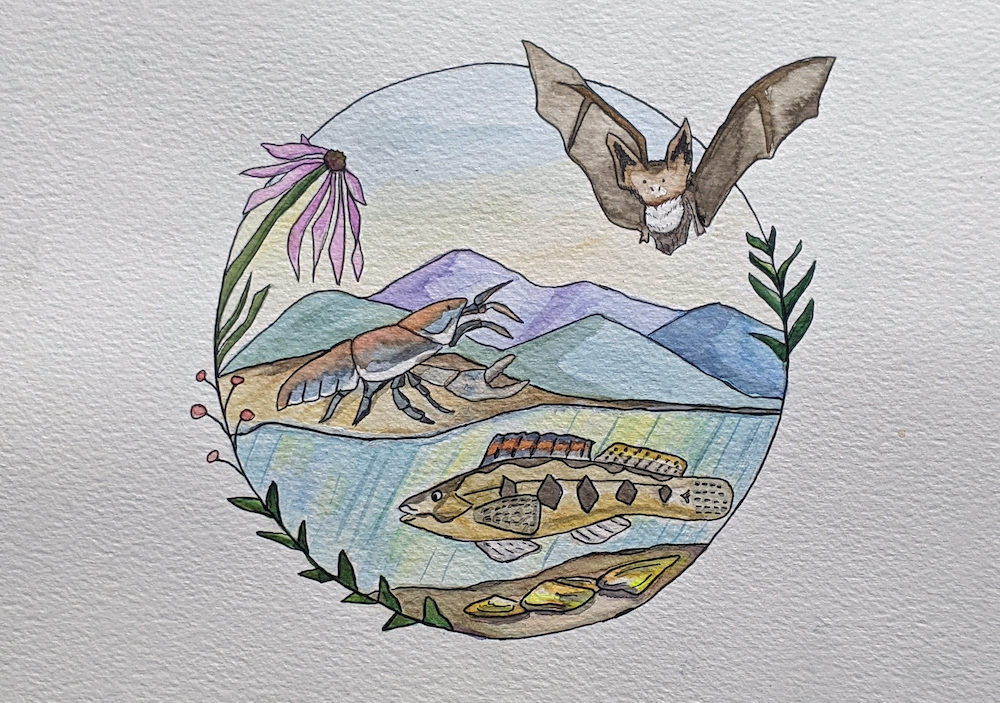
The Endangered Species Act protects a multitude of species in Appalachia, including: the smooth purple coneflower, northern long-eared bat, Big Sandy crayfish, Roanoke logperch, and yellow lance mussel. Painting by Courtney Alley
Mere months after a University of Tennessee scientist discovered the snail darter in the Little Tennessee River in 1973, President Richard Nixon signed the Endangered Species Act into law. The federal government classified the little fish as endangered in 1975 and designated part of the river as critical habitat for the species — directly in the path of the Tennessee Valley Authority’s unfinished Tellico Dam.
Conservationists sued to stop construction of the multi-million dollar project, but TVA argued for its completion because it had already put $78 million into the dam. The legal battle escalated to the U.S. Supreme Court in 1978 in TVA v. Hill. The court affirmed the snail darter’s protections under the Endangered Species Act and halted the project.
But the victory was short-lived, as Congress soon bent to political pressure and exempted the Tellico Dam from the Endangered Species Act. TVA completed the dam in 1979. Scientists relocated some snail darters to nearby streams, and the species has since been downgraded to threatened status.TVA v. Hill was the Endangered Species Act’s first test, and the Supreme Court’s interpretation of the law upheld protections for the snail darter and set a precedent to do the same for the now 2,244 protected species. Conservationists have relied on these endangered species protections to help delay or halt projects like the Mountain Valley and Atlantic Coast pipelines that would destroy habitat and kill protected animals and plants.
Related: Get to Know Appalachia’s Vulnerable Species
Yet the act has not protected many species from the harms of mountaintop removal coal mining, and less federal funding to administer the law over the years has led to an ever-increasing backlog of species waiting to be considered for protections. Recent and proposed changes to the Endangered Species Act would weaken the bedrock environmental law and put wildlife protections in jeopardy.
“The impact of the Endangered Species Act in Appalachia has been a very mixed bag,” says Kat Diersen with Defenders of Wildlife, a nonprofit group that advocates for increased wildlife protections across North America. “It is an excellent tool in the right hands, and an almost worthless tool in the wrong hands. Some of the act’s greatest victories have been [in Appalachia], and some of our greatest failures have been here.”
Attacks on the Endangered Species Act
On July 31, federal agencies proposed changing the definition of “critical habitat” under the Endangered Species Act in ways that will limit the areas that can be protected under the law.
“The Trump administration is re-writing the definition of critical habitat solely to make it easier to drill, frack, mine, clearcut, and otherwise exploit lands and waters that endangered wildlife rely on,” said Drew Caputo with the nonprofit law group Earthjustice in a July 31 statement. “We are in the midst of a biodiversity crisis and nothing about this new definition helps animals and plants facing extinction.”
The proposed change to how critical habitat is defined was the latest in a stream of changes to the act put forward by the Trump administration. On June 4, the president issued an executive order calling for all federal agencies to look for potential cuts to the Endangered Species Act to help “facilitate the nation’s economic recovery” in the midst of the pandemic.
And in August 2019, the U.S. Fish and Wildlife Service finalized a series of rollbacks to the act, making it easier to remove species from the list and weakening protections for species classified as threatened. And for the first time, the agency announced it would incorporate economic considerations into decisions over whether to list a species as threatened or endangered instead of relying purely on science. USFWS also eliminated a requirement for federal agencies to consult with scientists when seeking permits for extraction projects such as oil drilling. Multiple lawsuits against these changes are ongoing.Charles Kwit, an associate professor in the Department of Forestry, Wildlife and Fisheries at the University of Tennessee, argues that weakening protections for threatened species is counterintuitive.
“They’re categorized as threatened because that means the species is likely to become extinct within the foreseeable future,” says Kwit. “So if we lift protections on something that we have deemed likely to become endangered, then I think we’re missing the point.”
Kat Diersen with Defenders of Wildlife calls the Trump administration’s changes to the Endangered Species Act a handout to extractive industries.
“Long story short, it would make it harder to argue that a species should be listed, it would make it harder to provide protections for them once they are listed, it would make it easier to justify not protecting them in favor of economic interests, and it would make it easier to take them off the list even if they are not, in fact, recovering,” says Diersen.
Putting a Price on Life
It’s historically been very tricky to incorporate economic factors into decisions about which species are federally protected, according to Charles Sims, director of the Energy and Environment Program for the Howard H. Baker Jr. Center for Public Policy at the University of Tennessee.“The economic considerations were not supposed to be considered for the listing decisions, but they could be considered for the preparation of the habitat management plans,” says Charles Sims about the law before the August 2019 change.
He states that fewer species would be listed as threatened or endangered over time if economics were brought into listing decisions.
“We don’t want the economic considerations to bias what we’re protecting, but we should be considering them when we’re trying to figure out kind of the least-cost way to go about protecting them,” says Charles Sims.
Currently, the Fish and Wildlife Service has a backlog of more than 550 species awaiting a listing decision under the Endangered Species Act. Charles Sims states that this large list is primarily due to a shrinking budget for the agency to administer the act.
Additionally, the Trump administration has only listed 19 species under the act as of September — far fewer compared to previous presidents. The Obama administration listed 115 in his first four years, George W. Bush’s administration listed 31 in his first four years, and Bill Clinton’s administration listed 304 species in his first four years.
“They actually came up with some innovative ways during the last administration to actually deal with this backlog and shrink it,” says Charles Sims. “I would’ve liked to have seen more emphasis paid to moving through this backlog instead of saying, ‘Oh, well the best way to fix this backlog is to just not list any more species.’”
Another complication with applying economics to species management is the permanence of extinction.
“If you get things wrong and the species survives, then it’s not a huge deal because you can adjust your policy to reflect what you’ve learned,” says Charles Sims. “But if you’re wrong and that species goes extinct, you don’t get a re-do.”
Implementing the Endangered Species Act can also bring economic benefits, according to Charles Sims.
“You’ve got tons of tourism dollars that have come from seeing these species and seeing the natural habitats that these species live in,” he says. “In a lot of cases, what people are coming to see is pristine forest and pristine natural areas in general.”
A Framework for Species Protection
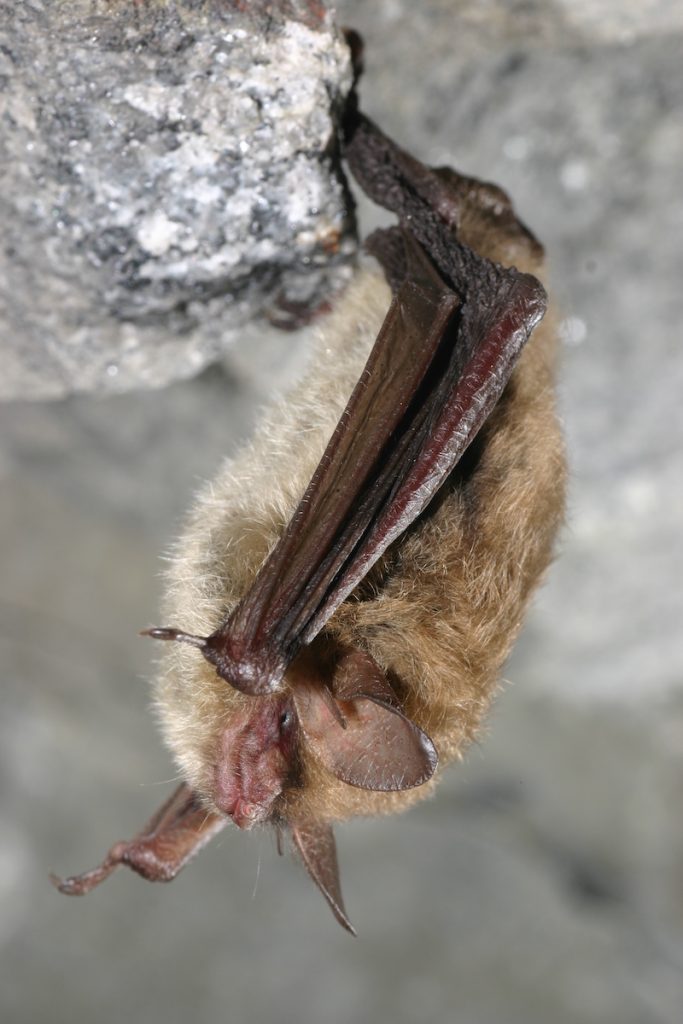
The endangered northern long-eared bat. Photo by Al Hicks/NYDEC (CC BY 2.0)
“I think in its purest sense, the act provides a framework to decrease the likelihood of extinction of some of our most vulnerable species,” says Kwit of the University of Tennessee. “And at this time, in what truly is a biodiversity crisis, it’s really important to have frameworks in place to, at the very least, minimize extinction.”
Researchers have called this biodiversity crisis the “Sixth Mass Extinction” — and it’s accelerating, according to a study published in June. Researchers found that humans have contributed to the extinction of more than 237,000 species since 1900 due to factors like climate change, habitat fragmentation and invasive species introduction, and more extinctions are likely to follow.
The mass extinction crisis stands to have a particularly large impact on the Southeast United States, which is one of the most diverse regions for aquatic species like the snail darter. According to the Center for Biological Diversity, the Southeast hosts 62 percent of the nation’s fish species and 91 percent of the country’s mussel species.
Related: The Southeast Freshwater Extinction Crisis
The Endangered Species Act helps to protect some of these species, including the Guyandotte River crayfish that the Fish and Wildlife Service listed as endangered in 2016. This crayfish, which was once found throughout the Upper Guyandotte River basin in West Virginia, is now found in only two streams due to years of mountaintop removal coal mining, logging and other extractive processes. In January 2020, the agency proposed classifying 445 stream miles in Central Appalachia as critical habitat for the Guyandotte River crayfish and the threatened Big Sandy crayfish.
But much of the damage to these species and others in the coal-impacted regions of Appalachia could possibly have been prevented if it weren’t for a 1996 agreement between the USFWS and the Office of Surface Mining Reclamation and Enforcement. The agreement, called a biological opinion, essentially allowed OSMRE to grant permits for surface mines in areas that contained threatened and endangered species without having to consult with the USFWS for each individual mine.Kat Diersen with Defenders of Wildlife states that the 1996 biological opinion had catastrophic effects on Appalachian wildlife.
“It got the science wrong, it got the projections wrong, it got the modeling wrong,” says Diersen. “Where it really, really failed was in its estimation of the cumulative impacts that would occur from multiple mine sites over multiple years over a landscape scale.”
The biological opinion was actually reissued in 2016 and was linked to the Stream Protection Rule, which passed in January 2017. But when Congress canceled the Stream Protection Rule under the Congressional Review Act the very next month, the 2016 biological opinion was no longer applicable and the government reverted to using the 1996 opinion. A coalition of environmental groups, including the Center for Biological Diversity, sued the federal government in 2019 arguing that it needed to issue a new biological opinion — and in May 2020, the groups succeeded. OSMRE agreed to consult with the USFWS by Oct. 16 about how mountaintop removal coal mining impacts protected species.
“As Trump officials slash environmental protections, it’s a major victory that endangered wildlife will get new safeguards at coal mines across the country,” said Tierra Curry with the Center for Biological Diversity in a May press release. “Greater protections for endangered animals will also benefit human communities that are harmed by coal pollution every day.”
Defending Species from Pipelines
Several threatened and endangered species have been further put at risk by fracked gas projects like the 303-mile Mountain Valley Pipeline from West Virginia to Virginia. The 600-mile Atlantic Coast Pipeline also threatened vulnerable habitats, but developers canceled the project, in part because of years of delays due to legal challenges to various permits — including an authorization that would have allowed developers to kill a certain number of threatened and endangered organisms in the pipeline’s path.

Mountain Valley Pipeline sections and a cleared right-of-way in Craig County, Va., in May 2020. Photo courtesy of Mountain Valley Watch
“A new biological opinion does not change the fact that a significant amount of construction has and would occur in sensitive habitats that contain endangered species,” says Appalachian Voices Virginia Field Coordinator Jessica Sims. “Years of sediment pollution from construction efforts have resulted in harmful cumulative impacts to the waterways which the endangered Roanoke logperch and candy darter call home.”
The pipeline developers received several other permits on Sept. 25, but Appalachian Voices and others filed a legal challenge. Another environmental review for Mountain Valley Pipeline’s crossing of the Jefferson National Forest is also moving forward, but the pipeline is still missing a permit from the U.S., Bureau of Land Management.
Mountain Valley Pipeline Southgate, which would extend the mainline by 73 miles into North Carolina, is also facing scrutiny related to threatened and endangered species. During the permitting process, developers are required by law to survey for at-risk species and explain how they will mitigate damaging impacts in an environmental impact statement. But Perrin de Jong with the Center for Biological Diversity states that developers shortcut the Endangered Species Act requirements in several ways, including failing to properly survey the route. The Federal Energy Regulatory Commission, the agency responsible for reviewing the company’s environmental impact statement, approved it anyway.
For example, the company behind MVP Southgate, according to de Jong, identified 271 acres of potential suitable habitat for the threatened small-whorled pogonia, but only surveyed around 183 acres. And for the endangered smooth purple coneflower, developers found roughly 88 acres of suitable habitat, but only surveyed about 65.
“There’s all these acres they didn’t survey or try to survey, and they didn’t try to explain why,” says de Jong.
He adds that MVP Southgate also claimed that there are no roost trees for the endangered northern long-eared bat in the pipeline’s route — but developers never surveyed for the species. De Jong also points out that developers have said they may withdraw water from the Dan River, which provides habitat for the endangered Roanoke logperch, but their environmental impact statement failed to state how much water they would withdraw or where, much less how that would impact the fish or how MVP Southgate would mitigate the harm.
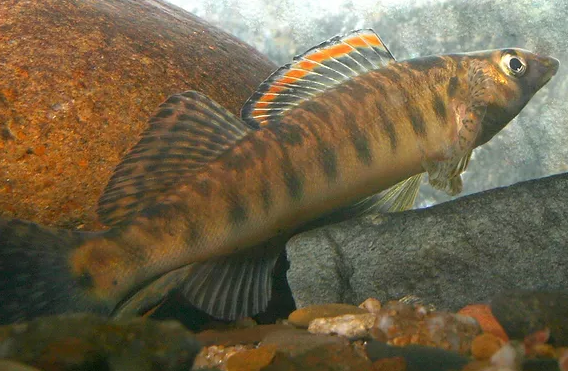
The endangered Roanoke logperch. Photo courtesy of Conservation Fisheries, Inc.
With construction still stalled on the mainline, North Carolina regulators denied a water quality permit for MVP Southgate on Aug. 11, stating that work on the project “could lead to unnecessary water quality impacts and disturbance of the environment in North Carolina.” Conservationists cheered this as a victory for communities and vulnerable species in the path of the pipeline. The company is now appealing the agency’s decision.
The fact remains, however, that the Trump administration already weakened the Endangered Species Act and plans additional rollbacks. Kat Diersen with Defenders of Wildlife states that the effects of these changes would hit Appalachian communities and wildlife.
“Communities, especially small communities, will pay the price in terms of environmental harm,” says Diersen. “Wildlife will pay the price in terms of irreclaimable loss of habitat.
“We will absolutely lose habitat, and we will squeeze what species remain into ever-smaller and smaller corners of their habitat until they blink out,” she adds.
Even so, Diersen states that the United States’ Endangered Species Act is arguably the strongest such law in the world.
“People across the board love this act,” she says. “But their voices are largely subsumed by the more economically powerful voices of corporate interests, especially the extraction industries.”
Related Articles
Latest News
More Stories

Leave a comment
Your email address will not be published. Required fields are marked *



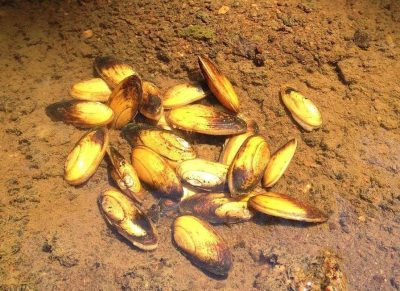

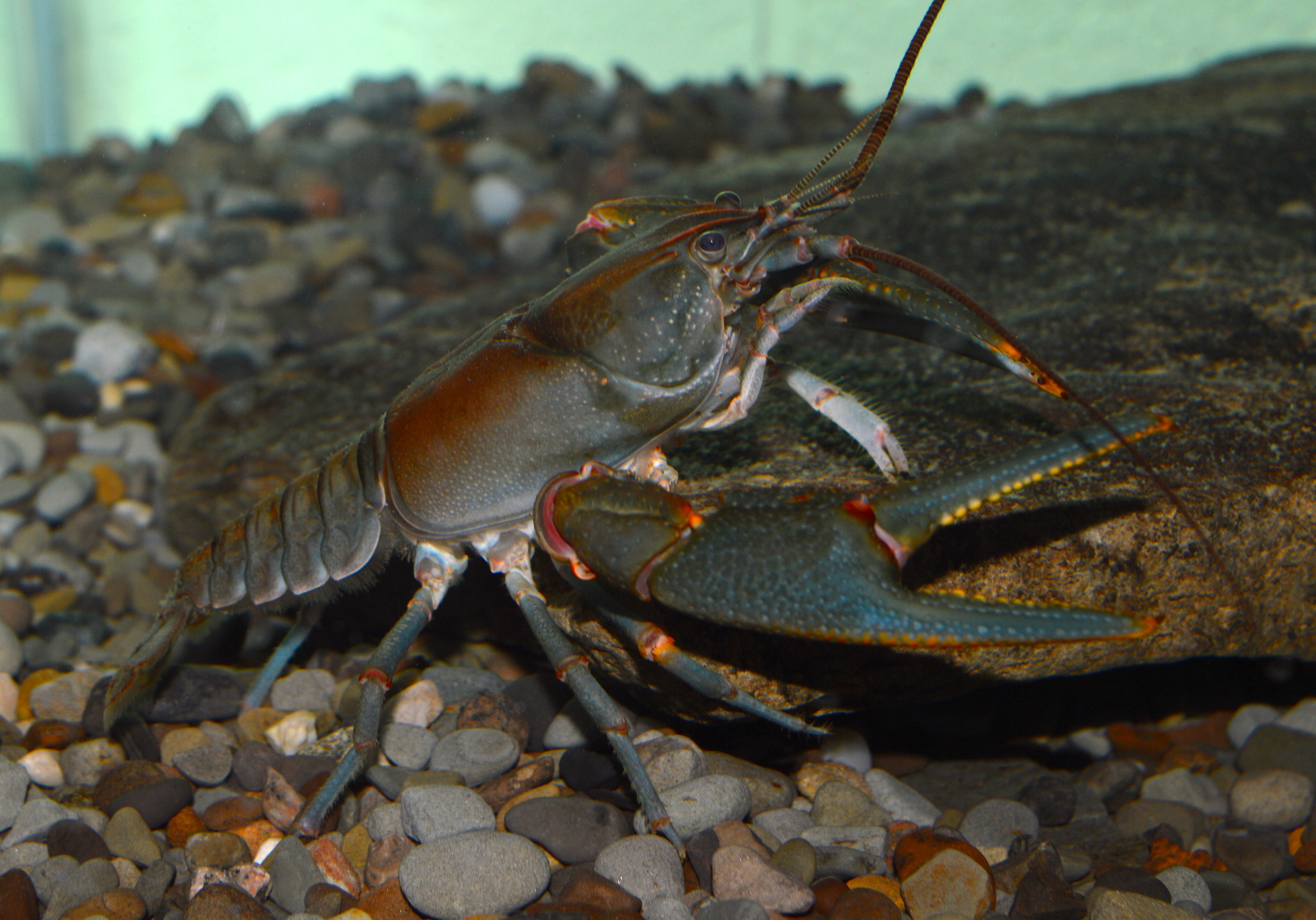



I never see this species in my country
Yes agree. What should they do so that they are not threatened if the law is enacted?